Self-Priming Slurry Mixing and Transfer Pump
Continuously mix slurry to prevent clumpy settling, allowing pump operators to easily transfer slurries from containers with our self-priming slurry mixing and transfer pump equipment. Sales QuoteContact UsKeeps High Solids Slurries Mixed and Transfers With Ease
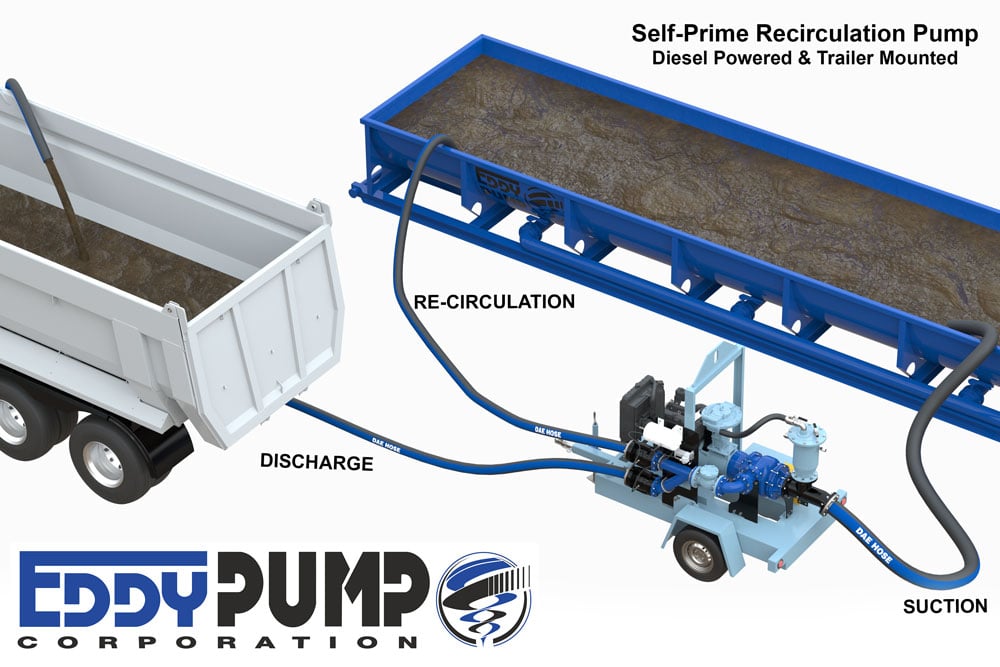
Keeping viscous slurries mixed helps prevent the settling of high solids sludge and slurries with low downtimes
The EDDY Self-Priming Slurry Mixing and Transfer Pump incorporates a vacuum-assisted priming slurry pump, a slurry container, a suction/discharge hose, and a recirculation hose. These components work in conjunction allowing for the EDDY Pump to continually mix the slurry within the slurry storage container, keeping it from settling, allowing for easy slurry transfers to a truck or another disposal means.
Most EDDY Pumps are submersible, however, with a self-priming unit, the pump and power unit are not submerged. The suction hose goes into the slurry and the unit acts like a super-sized wet vacuum.
This Video shows a smaller electric 3-Inch EDDY Self-Prime flowing at 400 GPM (2 cu yd) of slurry at distances of 400 ft in under a minute.
4-inch and 6-inch Diesel Trailer Units are the most Popular.
The core of this design is the patented EDDY Pump technology. The design redefines the pumping industry by being the only pump that utilizes the principles of a tornado to create a synchronized eddy current. This pump is not a centrifugal, positive displacement or vortex pump, but instead the most highly efficient high solids and high specific gravity pump on the market.
To learn more about the technology behind our self-priming non-clog pumps continue reading more HERE.
[/et_pb_text]For High-Solds Slurries Found in:
Mining Dewatering, Drill Cuttings Transfer/Disposal, Viscous Chemical Applications, Oil & Gas Applications, eliminating the need for vacuum trucks and costly excavators.
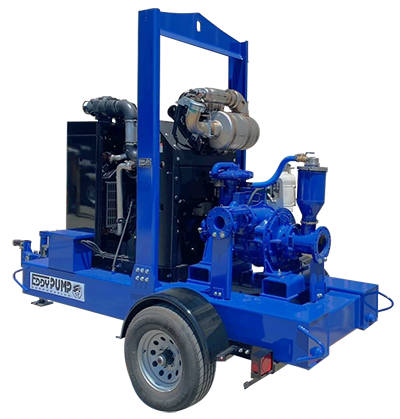
An ideal system for keeping high solids slurries continuously mixed while also using the pump to move the highly viscous slurries without clogging or having significant downtime. Lower downtime and maintenance issues versus conventional centrifugal or positive displacement pumps will save your project money. Pump size options range from the 2-inch slurry pump, up to a 12-inch option. Our system handles pumping distances over 3500 feet and production rates up to 4000 GPM.
All of our pump and dredging equipment is equipped with our dependable industrial slurry pumps, which are non-clog pumps designed for high solids pumping applications and other tough jobs that require a true workhorse of a pump. Our patented pump technology outperforms all centrifugal, vortex and positive displacement pumps in a variety of the most difficult pumping applications saving your project from downtime, repairs which offer increased ROI over traditional pumps with frequent maintenance issues when dealing with tough slurries and abrasive materials.
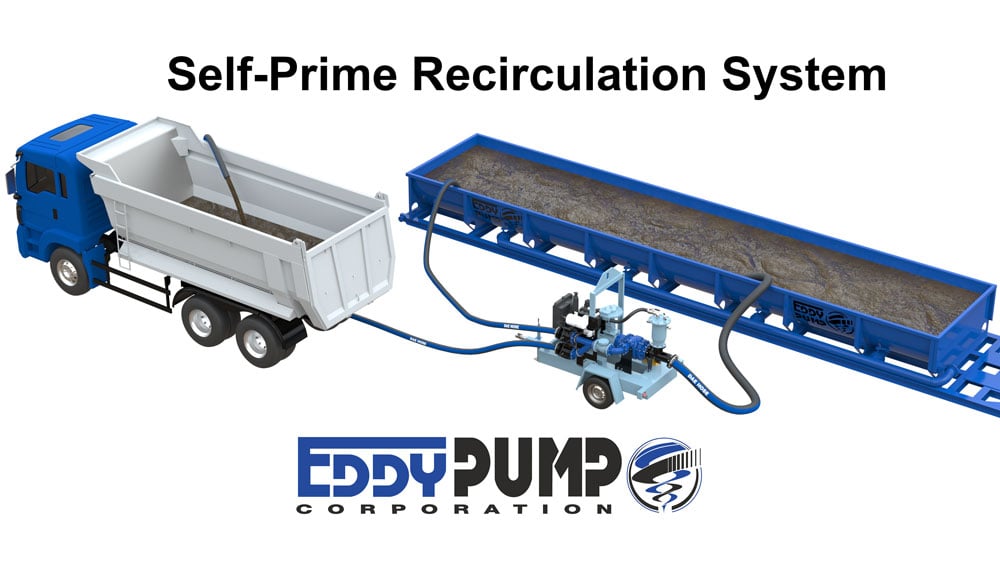
Alternative Deployment. Self-Prime Excavator Deployed.
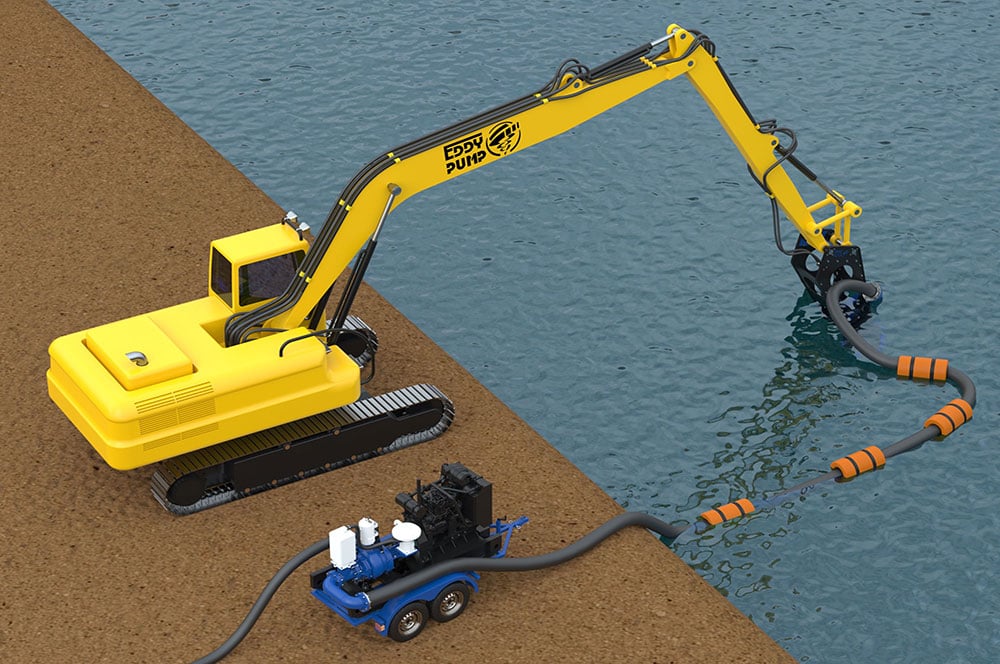
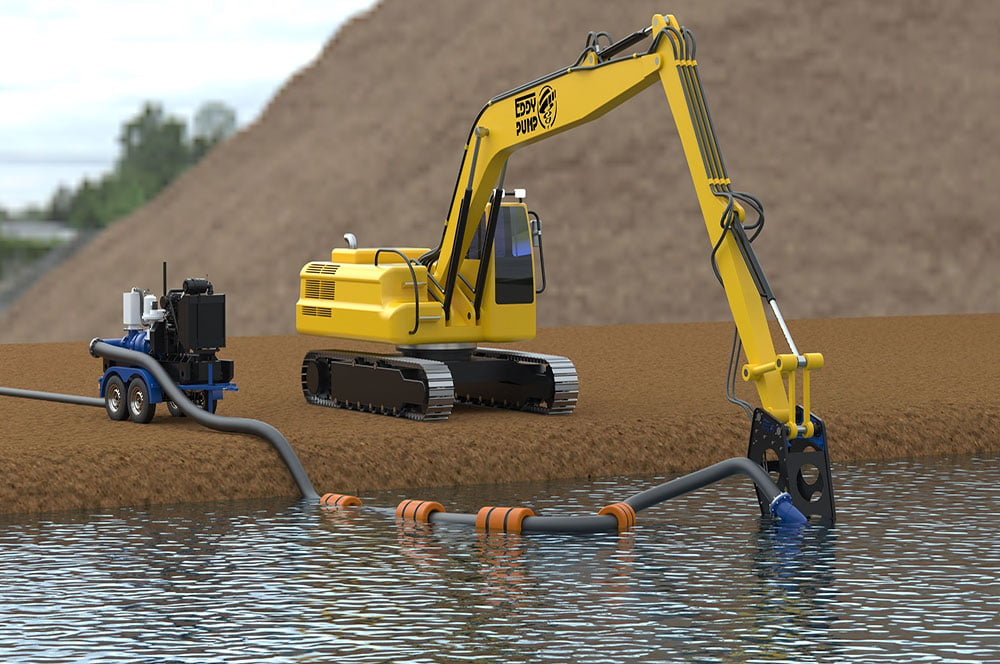
Self-Priming Slurry Mixing and Transfer Pump Advantages
- Keeps High-Solids Slurries Mixed with Recirculation Option
- Uses EDDY Pump to Handle Mixing and Transfer
- Secondary Vacuum Pump Allows Constant Priming
- Works Like a Giant Wet Vac
- Move 30-70% Solids
- Powered by Electric or Diesel
- Non-Clog, High Viscosity, High Specific Gravity, High Abrasives, Low pH Pumping Design
- Easily Process Rags, String, Rocks and Foreign Objects That Frequently Clog Other Pumps
- Multiple Mounting Options, (Skid, Trailer, Stationary)
Call for Sales or Support
If you need help with Pump Selection, Sales or Engineering Support
Call 619-404-1916
NOEX Drill Cuttings & Tank Pump System

The NOEX® System
NOEX Allows you to pump directly from the Tailings tank into the truck! Eliminate the costly need for excavators and hazardous conditions for on-site personnel.
The NOEX® Cuttings Pump & Tank requires less manpower and vastly improves safety for on-site personnel. In addition, the NOEX® System provides a 5-fold increase in production rates in the removal and transportation of mud, cuttings, and drilling fluids when compared to excavators.
Each NOEX® Tank is equipped with a redundant motor and pump, allowing for 100% uptime. Optional recirculation and water jet options can be added to keep the material constantly agitated, making it easier to pump. The NOEX® Pumps can be mounted outside of the tank as a flooded suction or can be fully submerged in the cuttings tank.

The EDDY Self-Priming Pump integrates a vacuum-based priming unit, which allows the EDDY Pump to operate at peak performance without the need to constantly prime the pump. They’re perfect for pumping highly viscous or heavy fluids without blocking the line or breaks in the process. EDDY Pumps require minimal maintenance and come in a wide range of size options to cover any liquid or slurry transfer project. EDDY Pumps are prepared to handle pumping distances over 3,500 feet and production rates up to 4,000 GPM.
The EDDY Pump self-priming pump unit can be run electrically or diesel-driven to fit in all conditions and meet stringent factory and regulatory standards. Also, with no critical tolerances, the non-clog EDDY Pump will last years with little to no maintenance.
Find Out What Makes the EDDY Pump Superior for Tough Dredging Projects:

Dewatering geotextile bags are perfect for materials that can be dewatered and dispersed on site.
Self-Priming Pump = Cost Savings
For example, a recent client in the manufacturing space was paying over $200,000 every year for vacuum truck companies to frequently come out and collect the waste in their sumps. To combat the rising costs, they tried using other pumps but there was a high failure rate because of large debris and abrasive slurries which would clog the pump, creating maintenance and downtime issues.
This was solved with a 2-inch self-priming EDDY Pump for less than 10% of the annual vacuum truck costs!
Pump Applications That Will Benefit From an EDDY Self Priming Pump
Manufacturing: Large pits or sumps collect all the waste, sludge and wash off from the manufacturing processes. This material is often laden with multitudes of chemicals, abrasive debris and solids which can quickly wear down traditional pumps.
Paper/Pulp Production: Concrete sumps and basins are frequently filled with caustic chemicals and chunks of trees and bark as part of the paper manufacturing process.
Oil/Gas/Drilling: Drilling mud pumping and drill cuttings from tanks and waste disposal ponds often need to be cleaned out and removed off-site.
Dewatering: Some of the most common dewatering techniques involve submersible dewatering pumps, siphoning, or using large machinery buckets to catch the water and dump off-site. These techniques are performed when the water that needs to be removed is below the designated discharge area.
Fundamentally, the main motivating factor to switch to a self-priming pump unit is to save on costs. By running some quick numbers, you should be able to quickly determine if your company can save money by converting existing systems to a self-priming unit. For additional information on self-priming pump units, click here.

Questions About Self-Priming Pumps?
Slurry Pumps
Why EDDY Pumps Are Better – Highlights
This video shows how EDDY Pump beats out traditional centrifugal pumps when it comes to tough slurry and abrasive materials. EDDY Pump is the at the heart of all of our featured dredge pump equipment including the Remote Operated Subdredge, Diver Operated Pump and a Excavator Attachment Dredge Pump.
Frequently Asked Questions
What is a self-priming pump, and how does it work?
A self-priming pump is designed to prime itself without external assistance automatically. It utilizes a combination of air and water to create a vacuum within the pump casing, allowing it to draw fluid into the suction line and begin pumping. This eliminates the need for manual priming, making it ideal for applications where priming water is not readily available.
What types of fluids can the self-priming slurry pump handle?
Our self-priming slurry pump is precisely engineered to handle abrasive and viscous fluids, including slurries, mud, sludge, and thick liquids with high solids content. It excels in industries such as mining, dredging, construction, and wastewater treatment.
What are the key advantages of using a self-priming pump?
Ease of Operation: Eliminates the need for manual priming, reducing downtime and labour costs.
Versatility: Can handle a wide range of fluid viscosities and solids concentrations.
Portability: Self-priming capability allows for easier relocation and deployment in various job sites.
Efficiency: Efficiently transfers fluids with minimal clogging and downtime, improving overall productivity.
How do I ensure optimal performance and longevity of the pump?
Regular Maintenance: Follow recommended maintenance schedules provided in the user manual, including inspection of seals, bearings, and impeller.
Proper Installation: Ensure the pump is installed on a stable foundation and aligned correctly with the piping system.
Monitor Operating Conditions: Keep an eye on suction conditions, discharge pressure, and fluid characteristics to prevent overload or damage.
Use Genuine Parts: Replace worn-out components with genuine EDDY Pump parts to maintain performance and reliability.
Can the pump handle highly abrasive materials?
Yes, our self-priming slurry pump is specifically designed to handle abrasive materials commonly found in mining, dredging, and industrial applications. The patented EDDY Pump design features a recessed rotor that minimizes wear and extends the pump’s service life, even when pumping highly abrasive slurries.
What are the power requirements for operating the self-priming pump?
Power requirements vary depending on factors such as pump size, flow rate, and operating conditions. It’s essential to consult the pump specifications and consult with our technical team to determine the appropriate power source and electrical requirements for your specific application.
Can the pump be customized to suit my specific application requirements?
Yes, our self-priming slurry pumps can be customized to meet the unique needs of your application. Whether you require specific construction materials, custom pump sizes, or additional features, our engineering team can work with you to develop a tailored solution that meets your requirements and maximizes performance.
What is the typical lead time for ordering a self-priming slurry pump?
Lead times may vary depending on factors such as pump size, configuration, and current demand. We strive to provide fast turnaround times for standard pump configurations, typically ranging from weeks to a few months for custom orders. Contact our sales team for the most accurate lead time estimate based on your specific requirements.
Do you offer technical support and assistance for installation and troubleshooting?
Yes, our team of experienced engineers and technical support staff is available to assist you with installing, operating, and troubleshooting your self-priming slurry pump. Whether you have questions about pump selection, installation guidance, or troubleshooting advice, we’re here to help you every step of the way.
What warranty coverage is provided for the self-priming slurry pump?
We stand behind the quality and reliability of our products, and each self-priming slurry pump is backed by a comprehensive warranty against defects in materials and workmanship. Warranty terms may vary depending on the specific pump model and application. Please refer to the warranty documentation for your pump for details, or contact our customer service team for assistance.
What is a self-priming pump?
A self-priming pump is a type of pump that has the ability to prime itself without external assistance automatically. It utilizes a mechanism to evacuate air from the suction line and create a vacuum, allowing it to draw fluid into the pump casing and begin pumping.
What is the working principle of a slurry pump?
The working principle of a slurry pump involves converting rotational energy from a motor into hydraulic energy to transport abrasive or viscous fluids, known as slurries. This is achieved by using an impeller that rotates within the pump casing, creating a centrifugal force that propels the slurry through the pump’s discharge outlet.
What are the advantages of a slurry pump?
Ability to Handle Abrasive Materials: Designed to withstand the erosive effects of abrasive slurries commonly found in industries such as mining, dredging, and construction.
Efficient Transfer: Utilizes centrifugal force to transport slurries over long distances and varying elevations efficiently.
Durable Construction: Constructed with robust materials and specialized coatings to resist wear and corrosion, ensuring long service life.
Versatility: Capable of handling a wide range of fluid viscosities and solids concentrations, making it suitable for diverse applications.
Is a self-priming pump good?
Yes, a self-priming pump offers several advantages, including eliminating the need for manual priming, reducing downtime, and improving operational efficiency. It is particularly beneficial in applications where priming water may not be readily available or practical.
What are priming pumps used for?
Priming pumps, including self-priming pumps, are used to remove air or gas from the suction line of a pump, creating a vacuum that allows the pump to draw fluid into the system. They are commonly used in situations where the pump is located above the fluid level or when the suction line contains air pockets that need to be evacuated.
Which is the best, self-priming or centrifugal pumps?
The choice between self-priming and centrifugal pumps depends on the specific application requirements. Self-priming pumps offer the advantage of automatic priming, making them suitable for situations where priming water is not readily available. On the other hand, centrifugal pumps are generally more efficient for high-flow, low-viscosity applications. The best pump for your needs will depend on factors such as fluid viscosity, solids content, suction conditions, and operational preferences.
